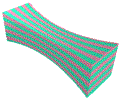3-D Animation on the Web: Creative Goals
     
|
Creative GoalsLet's start by blithely ignoring technological restraints for a moment and focus on the kind of product we want to create. Once we know the direction we're headed, let's see how far we can get in today's environment. |
|
A 3-D animated loop is...a concept in time. |
The commercial strength of a 3-D animated loop depends on concept. A 3-D animated loop IS a concept--or rather it must be if it stands a chance of pulling and holding a viewer's attention. It's a concept in time. Most people first entering 3-D graphics think of creating "objects." Those of you who took a philosophy class in college may remember the old "object hypothesis." Say you're looking at a table. Even though your perception is limited to a two-dimensional projection of light on the retinas of your eyes, you're still convinced that the table is really a three-dimensional object in space. You can test it by walking around the table. Each new view confirms the "object hypothesis" there is really only one three-dimensional object behind the many different views. |
Learn to think in terms of the flow of visual energy through time. |
In the same way, one can be tempted to create models in 3-D applications, and then "prove" that they are really in 3-D by rotating them, as in the ubiquitous globes turning all over the Web. Equally common is the block of sculpted text rotating stately on its own axis. This stuff is worse than boring; it is commercially worthless. It gives no pleasure to the viewer, nor does it command his or her attention. In a good animated loop, the objects only serve the concept, which must have energy through creative change and movement. A good concept is not a question of repeating a unit of change, but of the effect of the repetition itself. The backbeat rhythm of the Rolling Stones, the shuffle of reggae, and the swirling triplet of a waltz--these are all repetitions of a small time unit, but the effect is one of a living pulse or a flowing stream. Learning to think in terms of the flow of visual energy in time is the big artistic challenge that graphics designers face when moving into this medium. |
The public craves magic. Magic is the violation of an established realism through transformation. |
Magic is what the public craves. The motion picture industry today is obsessed with high-end effects because people love them. The essence of the magical effect is the violation of an established realism through transformation. Something that doesn't look real to begin with cannot appear magical. 3-D graphical tools have fantastic capacity to create a magical effect simply because objects can appear so tangibly material that their metamorphosis on the screen mystifies the viewer. The obvious example is the now hackneyed effect that turns a human being into a pool of liquid metal on the floor. |
 |
This example, a logo for a fictitious company named Mind Candy (perhaps a video game producer or multimedia company) demonstrates these concepts in a simple and straightforward way. The object is initially established as a rigid solid, both by shape and by the straight bands on the surface. But the expectations we have of a rigid body are then violated by the fluid corkscrew wave passing through. The repetition of this cycle is given energy and continuity by the elastic flexing, the stretching and compressing of the entire object, in the same way that an upbeat drives the downbeat in a dance rhythm. Humor and a certain sentiment is created by the reminiscence of the salt-water taffy pullers found at the old-fashioned seashore resorts. |
Comments are welcome
Created: Jan. 14, 1997
Revised: May 11, 1997
URL: https://webreference.com/dev/3d/goals.html


 Find a programming school near you
Find a programming school near you